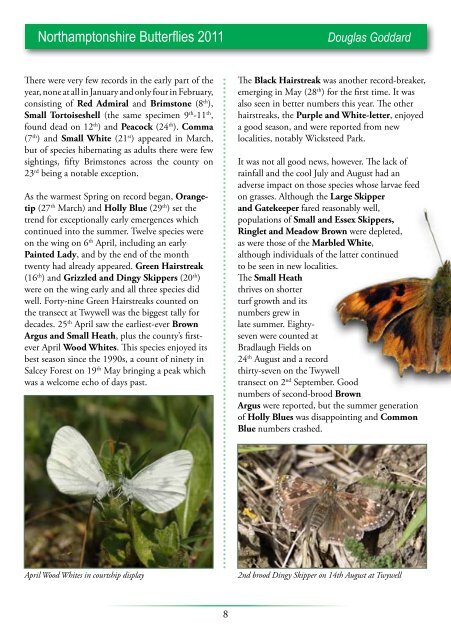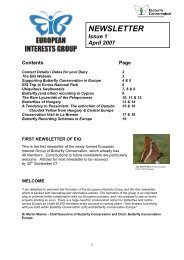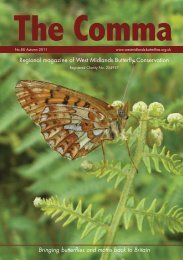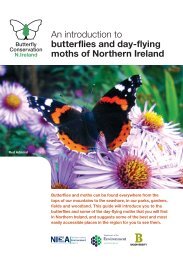Spring 2012 newsletter - Butterfly Conservation
Spring 2012 newsletter - Butterfly Conservation
Spring 2012 newsletter - Butterfly Conservation
Create successful ePaper yourself
Turn your PDF publications into a flip-book with our unique Google optimized e-Paper software.
Northamptonshire Butterflies 2011 Douglas Goddard<br />
There were very few records in the early part of the<br />
year, none at all in January and only four in February,<br />
consisting of Red Admiral and Brimstone (8 th ),<br />
Small Tortoiseshell (the same specimen 9 th -11 th ,<br />
found dead on 12 th ) and Peacock (24 th ). Comma<br />
(7 th ) and Small White (21 st ) appeared in March,<br />
but of species hibernating as adults there were few<br />
sightings, fifty Brimstones across the county on<br />
23 rd being a notable exception.<br />
As the warmest <strong>Spring</strong> on record began, Orangetip<br />
(27 th March) and Holly Blue (29 th ) set the<br />
trend for exceptionally early emergences which<br />
continued into the summer. Twelve species were<br />
on the wing on 6 th April, including an early<br />
Painted Lady, and by the end of the month<br />
twenty had already appeared. Green Hairstreak<br />
(16 th ) and Grizzled and Dingy Skippers (20 th )<br />
were on the wing early and all three species did<br />
well. Forty-nine Green Hairstreaks counted on<br />
the transect at Twywell was the biggest tally for<br />
decades. 25 th April saw the earliest-ever Brown<br />
Argus and Small Heath, plus the county’s firstever<br />
April Wood Whites. This species enjoyed its<br />
best season since the 1990s, a count of ninety in<br />
Salcey Forest on 19 th May bringing a peak which<br />
was a welcome echo of days past.<br />
8<br />
The Black Hairstreak was another record-breaker,<br />
emerging in May (28 th ) for the first time. It was<br />
also seen in better numbers this year. The other<br />
hairstreaks, the Purple and White-letter, enjoyed<br />
a good season, and were reported from new<br />
localities, notably Wicksteed Park.<br />
It was not all good news, however. The lack of<br />
rainfall and the cool July and August had an<br />
adverse impact on those species whose larvae feed<br />
on grasses. Although the Large Skipper<br />
and Gatekeeper fared reasonably well,<br />
populations of Small and Essex Skippers,<br />
Ringlet and Meadow Brown were depleted,<br />
as were those of the Marbled White,<br />
although individuals of the latter continued<br />
to be seen in new localities.<br />
The Small Heath<br />
thrives on shorter<br />
turf growth and its<br />
numbers grew in<br />
late summer. Eightyseven<br />
were counted at<br />
Bradlaugh Fields on<br />
24 th August and a record<br />
thirty-seven on the Twywell<br />
transect on 2 nd September. Good<br />
numbers of second-brood Brown<br />
Argus were reported, but the summer generation<br />
of Holly Blues was disappointing and Common<br />
Blue numbers crashed.<br />
April Wood Whites in courtship display 2nd brood Dingy Skipper on 14th August at Twywell







